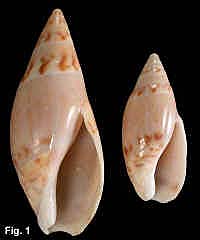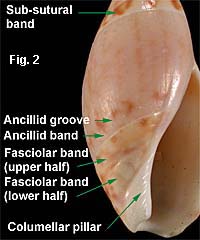

|
Amalda
oblonga (Sowerby, 1830)
Description: Shell moderately broad with body whorl expanded, aperture length
two-thirds of total shell length. Spire
calloused, callus terminating in front of the aperture; suture concealed
by callus. Spire whorls
smooth. Body whorl with calloused subsutural band at top, edged by deep
groove. Non-calloused
part of body whorl with microscopic axial and spiral striae.
Columella pillar with about six very weak plaits; fasciolar band with
central ridge or groove, upper and lower halves flat and smooth; ancillid band
narrow, poorly defined, bordered above with an indistinct groove (not
visible in figs. 1 & 2).
Non-calloused area of body whorl fawn occasionally with axial zigzag
streaks of brown; subsutural band white with axial brown flames; whole
base of shell from above the ancillid groove, the ancillid band and both
halves of anterior fasciole streaked or suffused with brown; pillar area
white, sometimes suffused with brown.
Operculum brown, corneous.
Size:
Length up to 28 mm.
Distribution: Endemic to
Australia
;
Moreton Bay
,
Queensland,
to south-western
Western Australia
, including
Tasmania
.
Habitat:
Subtidal, down to 150 metres.
Not
taken alive intertidally, but common as a beach shell.
Comparison:
This species is the most common of the genus as a beach shell
around
Sydney
and in northern NSW; it
is recognized by its two brown bands, sometimes accompanied by fine
axial lines. A.
edithae, which has a similar colour pattern, is slender, deep water
and rare in NSW. A.
festiva is similar to large specimens of A.
oblonga, but the former occurs in deep water.
See A. marginata for
comparison with that species.
Figs. 1,2:
Gerringong, NSW (C.086226, both specimens)
|